Mini burgers are all the rage
 Seems like every restaurant I go to these days has mini-burgers or sliders on the menu.
Seems like every restaurant I go to these days has mini-burgers or sliders on the menu.
But this might be taking it a little too far...
 Seems like every restaurant I go to these days has mini-burgers or sliders on the menu.
Seems like every restaurant I go to these days has mini-burgers or sliders on the menu.
But this might be taking it a little too far...
Posted by
Tammy Coxen
at
11:14 AM
2
comments
![]()
A few times a year I make chocolate truffles to sell to friends and neighbors and coworkers. It's my little cottage industry that helps me pay for things like Zingerman's special dinners, or my upcoming trip to Chicago. I know a couple of people who are vegan or otherwise sensitive to dairy, and they asked if I'd thought about making vegan truffles. Not one to turn down a challenge, I started looking in to it.
For dark chocolate truffles like I make, the main non-vegan ingredient is the cream. Cream brings both a liquid component and fat to the truffle equation. There are lots of other liquids you could use for truffles, but most of them don't have enough fat. Even soy cream subsitutes are lower in fat than the real thing. But coconut milk is a high fat liquid that at least one vegan truffle maker uses, so I decided to give that a try.
But then I found out that not all sugar is vegan! So that added another wrinkle to the project, since most chocolate contains sugar, and ingredient lists don't often specify whether it is bone-char processed... So I needed to figure out what chocolates were safe. Fortunately, this was easy enough, using the power of the Internet.
I went off to my local natural foods store and picked up a bar of Green&Black 72% baking chocolate to experiment with. On its own, I'm sad to say the stuff tasted pretty nasty, with a lot of heavy green notes. A little bit of greenness can be nice in a chocolate, but this was over the top. It was slightly better when made into truffles, but I wasn't happy with the results.
So this week I grabbed a couple different bars and did a taste test. Fortunately, both of these chocolates were better tasted plain than the first one I tried, so I was already off to a better start. Alone, I had a slight preference for the Endangered Species Supreme Dark Chocolate - it was a little rounder, a little sweeter, and had an interesting sort of nutty-coffee thing going on in the background. The Terra Nostra Organic 72% Intense Dark seemed darker and edgier and sharper, but with just a hint of what I hadn't liked in the first one. My fellow tasters were mixed in their preferences, so it was clear we needed to take it to the next step - an actual comparison of ganaches.
Fortunately, both of these chocolates were better tasted plain than the first one I tried, so I was already off to a better start. Alone, I had a slight preference for the Endangered Species Supreme Dark Chocolate - it was a little rounder, a little sweeter, and had an interesting sort of nutty-coffee thing going on in the background. The Terra Nostra Organic 72% Intense Dark seemed darker and edgier and sharper, but with just a hint of what I hadn't liked in the first one. My fellow tasters were mixed in their preferences, so it was clear we needed to take it to the next step - an actual comparison of ganaches.
The most surprising thing in the ganache making was the color. The Terra Nostra, which tasted so much darker, was actually surprisingly light colored as a ganache. Odd. It was also far, far superior in taste. The nutty-coffee thing in the Endangered Species overpowered the coconut milk and coconut extract in the ganache, whereas the Terra Nostra ganache was nicely integrated. Ding-ding-ding! We have a winner.
Posted by
Tammy Coxen
at
10:13 AM
3
comments
![]()
I ended part two of this series with some of the pros and cons of Calphalon Commerical Hard-Anodized cookware (and similar products). In my view, as someone who owns a bunch of Calphalon, there are a bunch of cons. Fortunately, there are some good alternatives that capitalize on the great heat conduction of aluminum but mitigate those problems.
The best known and mostly highly rated alternative is All-Clad. This is the brand that comes out on top of various cookware lists time and time again. It - and other brands like it - are based on "tri-ply" construction. Here's what that looks like: The interior of the pan is a high quality stainless steel surface. Stainless steel on its own isn't a great material for cookware - it doesn't conduct heat very well, or very evenly, so you end up with lots of hot spots. But it's a great surface to cook on. It gives you a nice sear, builds up a fond so you deglaze the pan for nice sauces, and best of all - it's virtually indestructible and can be cleaned with steel wool if things get really dire. It will stick, but if you preheat the pan and the oil before adding your food you can really minimize that.
The interior of the pan is a high quality stainless steel surface. Stainless steel on its own isn't a great material for cookware - it doesn't conduct heat very well, or very evenly, so you end up with lots of hot spots. But it's a great surface to cook on. It gives you a nice sear, builds up a fond so you deglaze the pan for nice sauces, and best of all - it's virtually indestructible and can be cleaned with steel wool if things get really dire. It will stick, but if you preheat the pan and the oil before adding your food you can really minimize that.
Underneath the stainless steel layer is a layer of aluminum, sandwiched between an outer layer of stainless steel. This pure aluminum core captures all of the great elements of aluminum that I talked about last time, but keeps the potentially reactive aluminum metal away from your food.
The outside layer of magnetic stainless steel gives All-Clad a shiny and attractive look while it's hanging on your pot rack. (So long as you clean the outside as thoroughly as the inside - that shiny silver exterior will show all the dishwashing lapses that Calphalon's dark gray finish hides.) In addition, that magnetic stainless layer makes All-Clad suitable for use on an induction cooktop (which heats by using magnetism to agitate the atoms of the pan itself). If that's not important for you, and you want a little extra insurance on heat conduction or prefer a darker exterior to your pan, All-Clad also makes a line called LTD that has an anodized aluminum exterior.
All-Clad is what's called, in the cookware world, "fully-clad" cookware. This just means that all the metal in the pan is that tri-ply construction. In some other manufacturers, only the bottom of the pan has an aluminum core or disc on the bottom. This distributes the heat evenly where you need it most, but the unclad sides can be prone to scorching, and - if the disc on the bottom does not extend all the way to the edges of the pan, then you can get a hot ring on the outside of the pan. For frying pans and saute pans, I'd definitely prefer a fully-clad item. But I have a Farberware saucepan with just a disc on the bottom, and I don't miss having extra thickness in the sides.
Pros: The best of both worlds - good cooking surface and good heat conduction in one pan. A couple of different exterior looks. Can work on an induction cooktop. Easy to clean, works with any utensil, can be beaten into submission with steel wool if necessary.
Cons: Expensive with a capital E! And then some. Did I mention that it's expensive? You can buy an entire set of lesser cookware for the cost of one All-Clad saute pan.
So in my view, this is one of those brands where it's definitely worthwhile to buy a piece or two, but the matched set is overkill. Skillets and saute pans are where you'll get the most bang for your buck (I'll talk about the difference between those in my next cookware post). For sauce pans, you'll probably be just as happy with something that's got a nice heavy reinforced bottom, but simply stainless steel sides.
Part One: Sets, Stock Pots and Cast Iron
Part Two: Anodized Aluminum
Posted by
Tammy Coxen
at
10:18 AM
3
comments
![]()
Labels: cookware
Not Fooling Anybody. Subtitled "A Chronicle of Bad Conversions and Storefronts Past" this website provides a tour of some not-so-dramatic transformations. The pictures are occasionally amusing, but it's the "creative interpretations" that will occasionally make you laugh out loud.
Their manifesto:
It is not without the bitter taste of self-awareness, specifically about the overwhelmingly crass and commercial (and, indeed, downtrodden and dreary, bleakly suburban, and economically grim) nature of the content of this site, that we at NFA embark on our quest to document bad conversions. That said, it is perhaps best that we look at this phenomenon as a delightful yet sad part of our culture's clattering landscape: it is an amusing diversion, it is an economic gestalt, it is a crime of design, it is a confusion to the would-be consumer. Let us rejoice in bad conversions and seek to amuse ourselves with them wherever possible, taking utmost pains to observe the careful, hopeless touches of their renovation and their indelible flourishes of nonsense on our landscape. Embrace blight! We have no other hope.
Posted by
Tammy Coxen
at
2:29 PM
1 comments
![]()
 I'm loving this website. You know those nutrition labels on the back of all packaged products? Well, this website contains that same information for hundreds of thousands of items, including meat down to the specific cuts. If you're paying attention to what you eat for any reason, you'll find something to like on the site. In addition to looking up all those different food items (and fast food too) the site has a tool that lets you easily compare different foods.
I'm loving this website. You know those nutrition labels on the back of all packaged products? Well, this website contains that same information for hundreds of thousands of items, including meat down to the specific cuts. If you're paying attention to what you eat for any reason, you'll find something to like on the site. In addition to looking up all those different food items (and fast food too) the site has a tool that lets you easily compare different foods.
My favorite feature is the pantry. You can add food items to the pantry, then use them to construct your own recipes and get your own nutrition label for the entire recipe, like this one for the salmon and fennel chowder I made for dinner last night.
My only annoyance with the website so far is that your pantry details are stored in a cookie on your computer, meaning you can only access the details from one location. However, you can export the data. Oh, and I guess I'm also annoyed about their limited selection of potato choices - only red or russet. What am I to do about my new white potatoes or my Yukon golds?
Posted by
Tammy Coxen
at
10:00 AM
2
comments
![]()
Gourmet Magazine has just come out with their every-five-years list of the best restaurants in the country and Chicago restaurant Alinea has come out on top!
I've linked to Alinea before, referencing chef Grant Achatz as one of the Chicago triumverate of techno-chefs/ molecular gastronomists. I've got a post about molecular gastronomy in the works, but for now here's a quick definition:Molecular Gastronomy applies the principles of chemistry and physics to cooking - by examining how foods react to different cooking methods, and which foods combine well on a chemical level, chefs are able to experiment with new food combinations and methods to create unusual menus with stunning results.
While Alinea and Achatz are firmly in the molecular gastronomy camp, they play with their food while also managing to make it taste good and providing top notch service. At least, that's what all the reports say - my first trip is coming up in little under a month. Having had the pleasure of eating twice at Achatz's previous restaurant, Trio, I've been eagerly anticipating a meal at the Alinea since the restaurant opened about a year and a half ago. Now I'm even more excited (and glad I made my reservation far in advance - it's always been a hard reservation to get, and will only get more difficult with this latest accolade).
From the Gourmet article:
Then the curtain goes up, and the fireworks begin. This is dining as performance art, and each tiny interactive dish teases, astonishes, delights. You pull out a pin and watch a little puff of cheesy hot potato drop into a tiny curved cuplet of soup that you slurp as if it were an oyster. A single perfect bite of lamb comes buried in smoldering eucalyptus leaves. A tiny ravioli is filled with the intensity of liquid truffle; it is almost impossible not to exclaim as it bursts inside your mouth. As you do, the servers smile, pleased by your pleasure; they too are participants in the experience, and they are there to help you enjoy the meal.You can expect to see my write up of my meal (and my entire culinary sojourn to Chicago) in about a month. Until then, check out the massive Alinea thread on eGullet, filled with tantalizing descriptions and pictures.
Posted by
Tammy Coxen
at
12:02 PM
0
comments
![]()
Labels: news
So, in my last post I talked about stock pots and cast iron pans. Before I go on, I should add a couple more words about stock pots. Most of us use our stock pots for boiling pasta water, or making soup or stews. For those purposes, a 6 or 8 quart pan is a great size. But if you actually want to use your stock pot to make stock, then you'll want something larger - 12, 16, even 20 quarts. Particularly when it comes to these larger pots, you don't need to invest in something fancy. "Better" cookware often has multiple layers, or a reinforced bottom, and all of these features are designed to aid heat conduction and reduce hot spots and burning. But since most stock making applications don't require a browning step, a cheap stainless steel pot is going to work just fine. And if your stock recipe does require browning, you can always just use that 12 inch cast iron pan we talked about last time, and transfer the contents into your stock pot (deglazing the pan to get all the good bits, of course).
Okay, back to pans. As I said in my last post, cast iron - while great - isn't right for every application. It holds a lot of heat, and if it gets too hot, even taking it completely off the heat won't cool it down very quickly, and your food can easily burn. Cast iron is also heavy, so if you need to move the pan around a lot, it can be a real pain. So for applications where you need to have more control, another material is called for.
After cast iron, one of the best conductors of heat is aluminum. Aluminum is in many ways the complete opposite of cast iron. It's lightweight. It's very responsive to change in the heat from your gas flame or electric burner. However, aluminum in it's natural form also has some drawbacks for cooking. Like cast iron, it's reactive. This means that it will interact with the food you put in the pan, and if that food is acidic (think tomatoes or lemon juice) you can end up with aluminum ions in your food. This effect means that cooking with cast iron is a good way to get some extra iron in your diet (and the taste effect is pretty minimal so long as you don't leave things sitting for hours). But aluminum has been implicated in Alzheimer's disease, so many people are wary of using raw aluminum cookware. And aluminum cookware doesn't even have a layer of "seasoning" to reduce it's reactivity, so it can really impact the flavor of foods.
Fortunately, there are a couple of different approaches to capturing the great heat conductivity of aluminum while mitigating the risks and drawbacks. Calphalon has traditionally been the best known name in anodized aluminum cookware, having made their name with their Commercial Hard-Anodized line.
What is Hard-Anodizing?
Hard-anodization is an electro-chemical process that hardens aluminum. (Hard-Anodized aluminum is 30% harder than stainless steel.) During hard-anodization, aluminum is submerged in an acid bath, then subjected to electrical charges. The result is a chemical reaction wherein the surface of the aluminum combines with oxygen to become aluminum oxide. This reaction is also known as oxidation, a process which occurs spontaneously in nature. Hard-anodization is actually controlled, accelerated oxidation.The anodizing process makes the aluminum non-reactive, thus addressing the chief flavor and health concerns related to aluminum cookware. Unfortunately for fans of their products, in 2004 Calphalon replaced their Commercial line with Calphalon One, a product they call "infused anodized" that incorporates a non-stick element into the metal of the pan, not just as a coating on top. I have no personal experience using Calphalon One line.
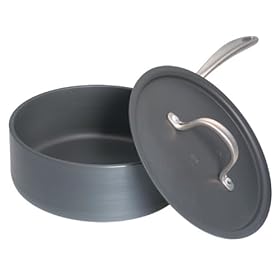 Fans of the Commerical Hard-Anodized line need not despair, as there are still plenty of pieces floating around the Internet, and there are other companies who make hard-anodized aluminum cookware. It's relatively expensive (although not as much as some of it's competitors.) I find Calphalon regularly at yard sales, where it's a great buy. Other people I know see it in resale shops. It's a dark gray matte metal, with heavy metal handles. It's functional rather than fancy in appearance. It's very high quality cookware, but like everything else, it has its pros and its cons, and it will be right for some people but not others.
Fans of the Commerical Hard-Anodized line need not despair, as there are still plenty of pieces floating around the Internet, and there are other companies who make hard-anodized aluminum cookware. It's relatively expensive (although not as much as some of it's competitors.) I find Calphalon regularly at yard sales, where it's a great buy. Other people I know see it in resale shops. It's a dark gray matte metal, with heavy metal handles. It's functional rather than fancy in appearance. It's very high quality cookware, but like everything else, it has its pros and its cons, and it will be right for some people but not others.
Posted by
Tammy Coxen
at
9:47 AM
4
comments
![]()
Labels: cookware
My first job when I moved to Ann Arbor was selling cookware and other products at a popular kitchen store here in town. It was a great opportunity to learn a lot about all sorts of kitchen gadgets. But selling cookware was often my favorite part of that job. I liked talking to people about how they cooked, and helping them figure out what cookware would be right for them. Many of them were older women or couples, people who had been gifted with a cookware set for their wedding and 20 years later, had decided it was time for a change. Most often people bought entire sets of cookware, and we were happy to sell them to them. (No, I wasn't working on commission, but sets made the decision making easy.)
Since that time, I've learned yet more about cookware, and gotten a lot more experience cooking. And I've decided that most of the time, sets aren't the way to go. Now, if your primary motive for a new cookware purchase is to have something pretty to hang in the show kitchen you never actually cook in, then a set of All-Clad LTD is probably exactly what you're looking for. Maybe even the copper clad, if you have live in help.
But for the rest of us, buying a set means you often end up with pieces you might not otherwise buy. Or at least, might not buy in that format. The previously mentioned All-Clad is excellent cookware. But it's very expensive. An All-Clad tri-ply 8 qt stock pot costs over $250. But very few of the applications you'd use an 8 qt stock pot for actually require all that fancy tri-ply construction. You're boiling pasta water, or making soup or (gasp) stock. For most people, a much cheaper stock pot will do the job just fine, and you can get some excellent buys on this sort of thing from your local restaurant supply store. When it comes to stock pots, even All-Clad agrees - they've introduced a lower priced line of large stockpots that have a reinforced disk at the bottom instead of being fully clad. So what should you buy, then? I can't claim to be a complete expert on cookware, but I do know what I like and what I use. And I've recently become a cast iron convert. Now, cast iron isn't for every application. It's slow to heat up, and slow to cool down. It holds a lot of heat, so it doesn't respond quickly to adjustments you make at the stove. But nothing is better at putting a really good sear on a steak, for example, and I find it suitable for a wide range of cooking applications. It goes seamlessly from the stovetop to the oven, and back again. Properly seasoned it is as non-stick as some teflon coated pans, and it's much easier to ensure that it is properly seasoned now that Lodge is selling pre-seasoned pans. You'll need to treat it right as you use it, but at least they get you off to a good start! Oh, and did I mention that it's cheap? And nearly indestructible? I think every kitchen needs at least one good cast iron pan. I prefer the 12 inch skillet, as I think it's the most versatile size.
So what should you buy, then? I can't claim to be a complete expert on cookware, but I do know what I like and what I use. And I've recently become a cast iron convert. Now, cast iron isn't for every application. It's slow to heat up, and slow to cool down. It holds a lot of heat, so it doesn't respond quickly to adjustments you make at the stove. But nothing is better at putting a really good sear on a steak, for example, and I find it suitable for a wide range of cooking applications. It goes seamlessly from the stovetop to the oven, and back again. Properly seasoned it is as non-stick as some teflon coated pans, and it's much easier to ensure that it is properly seasoned now that Lodge is selling pre-seasoned pans. You'll need to treat it right as you use it, but at least they get you off to a good start! Oh, and did I mention that it's cheap? And nearly indestructible? I think every kitchen needs at least one good cast iron pan. I prefer the 12 inch skillet, as I think it's the most versatile size.
Part Two: Anodized Aluminum
Part Three: Stainless Steel
Posted by
Tammy Coxen
at
8:00 AM
2
comments
![]()
Labels: cookware
You, like me, are probably thinking "Well, how the heck could sugar NOT be vegan?"
Turns out that the processing method for cane sugar refinement includes a step involving charcoal purification. And in some processing plants that charcoal is in the form of "bone char" - charcoal created from the leftover bones from meat slaughtering. This product used is so far processed from its animal origins that Kosher law considers bone char filtered sugar to be pareve, but for hardcore vegans it still presents a problem.
If you're a concerned vegan or vegetarian, you're in luck - sugar made from sugar beets does not require this step. However, it can be difficult to tell what plant the sugar you're buying is refined from, beets or sugar canes. For readers who have a Meijer nearby to frequent, they do label their store brand sugar as being from sugar beets. And of course, another option is simply to use alternative sweeteners or less refined cane sugar. (Beware of brown sugar, which is often just refined white sugar with molasses added back in.)
More info here.
And that's my "something new" learned for today! Of course, it just adds an extra wrinkle to the problem that I was researching in the first place (creating a vegan chocolate truffle) as now I have to worry about where the sugar in the chocolate comes from!
Posted by
Tammy Coxen
at
6:14 PM
0
comments
![]()
Labels: weird
 I'm recovering from a stomach bug, which has made me - unsurprisingly - not very interested in eating (or reading or writing or thinking about food). But woman cannot survive on saltines and applesauce alone (at least, this woman can't), so I decided it was time to try eating something a little more challenging.
I'm recovering from a stomach bug, which has made me - unsurprisingly - not very interested in eating (or reading or writing or thinking about food). But woman cannot survive on saltines and applesauce alone (at least, this woman can't), so I decided it was time to try eating something a little more challenging.
It's moments like this that I'm most glad to have some stock put away in the freezer. I went on a flurry of stockmaking activity last winter, then promptly abandoned that many containers of beef, turkey and chicken stock that had filled up the small freezer compartment of my refrigerator.
Under gentle urging from my husband to clear out some room, I've started finding reasons to use up stock these last few weeks. The pressure cooker risotto experiment. That great light summer pasta. And today - what better panacea for a hungry but tender stomach than a bowl of homemade beef stock with carrots and pasta stars?
The freezer is almost empty now. There's just one container of beef stock left - about enough for a batch of French Onion soup. Empty just in time, perhaps - because we're about to come up on stockmaking season again!
Posted by
Tammy Coxen
at
2:00 PM
0
comments
![]()
Labels: comfort food, lunch
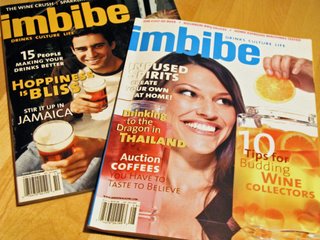 From the website:
From the website:
Imbibe is the magazine of liquid culture. It is a completely new way of looking at drinks—as a distinct culinary category, deserving in-depth exploration of history, ingredients, preparation, artistry and consumption. From wine, spirits and beer to coffee, tea and everything in between, Imbibe celebrates the world in a glass. In each issue, you’ll find compelling travelogues, engaging profiles, signature recipes and useful reviews—everything you need to know about the fascinating people, places, flavors and cultures of all things potable. Imbibe is your indispensable guide to all that’s fit to drink.I picked up the inaugural issue of Imbibe on a whim one day, and liked it enough that I've continued to buy each new issue. I'm even considering a subscription. It's a magazine that my husband and I can both appreciate. I take the wine and non-alcoholic drink articles, he takes the coffee geek and beer articles, and we split the cocktails down the middle. Imbibe offers a lot for us both to enjoy.
From Spanish molecular gastronomy mastermind Ferran Adria, comes Espesso. This "mousselike, cold solid sprayed right out of the canister" premiered in the US this week in Chicago. (A fitting location for it, given that most of America's own molecular gastronomist masterminds - Achatz, Cantu, Bowles - are located there.)
Espesso -- a play on the Italian word "spesso," meaning thick -- is essentially "taking coffee and solidifying it," said Joerg Oberschmied, vice president of operations for Lavazza, the 111-year-old Italian coffee company that is offering Adria's coffee creation.
Lavazza's three Chicago stores -- the company's only U.S. locations -- will be pouring or, rather, spraying espessos starting today. A serving costs $2.49.
Posted by
Tammy Coxen
at
7:22 AM
0
comments
![]()
 Made from the same grapes as port, this Portuguese red wine opens with lots of the fruit flavors you get from a ruby port. But instead of turning sweet and alcoholic on the finish, it's fully dry, with a great acid backbone, making it a great food wine. The first night we had it with the pork chops with smoked paprika and sherry vinegar, and it matched those big flavors blow for blow. It was just as good the second night with ratatouille and lamb. And at $10 a bottle from my favorite local wineseller, it's an absolute bargain! I'll definitely be buying a few bottles to have on hand.
Made from the same grapes as port, this Portuguese red wine opens with lots of the fruit flavors you get from a ruby port. But instead of turning sweet and alcoholic on the finish, it's fully dry, with a great acid backbone, making it a great food wine. The first night we had it with the pork chops with smoked paprika and sherry vinegar, and it matched those big flavors blow for blow. It was just as good the second night with ratatouille and lamb. And at $10 a bottle from my favorite local wineseller, it's an absolute bargain! I'll definitely be buying a few bottles to have on hand.
Posted by
Tammy Coxen
at
9:09 PM
0
comments
![]()
Labels: wine
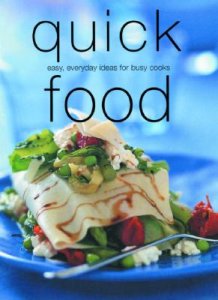 I love this cookbook. I'd forgotten about it for a while, when I wasn't cooking much, and recently rediscovered it, complete with many post-it-note marked recipes to try. Leafing through, I was reminded of how much I like it. It's a very stylish cookbook. Each recipe takes up only a page, with the opposite page containing a beautiful and appetizing picture. There are rarely more than 10 ingredients, but they're all real ingredients. Unlike most "quick" cookbooks, it doesn't rely on a convenience foods to make things fast. And best of all, it's a cookbook written for cooks - with only a single (small) page for each recipe, the instructions are sparse and assume you know what you are doing.
I love this cookbook. I'd forgotten about it for a while, when I wasn't cooking much, and recently rediscovered it, complete with many post-it-note marked recipes to try. Leafing through, I was reminded of how much I like it. It's a very stylish cookbook. Each recipe takes up only a page, with the opposite page containing a beautiful and appetizing picture. There are rarely more than 10 ingredients, but they're all real ingredients. Unlike most "quick" cookbooks, it doesn't rely on a convenience foods to make things fast. And best of all, it's a cookbook written for cooks - with only a single (small) page for each recipe, the instructions are sparse and assume you know what you are doing.
The roughly 200 recipes in this small chunky book are organized not according to ingredients or place in the meal, but by method of cooking. Pot. Pan. Wok. Grill. Oven. With the exception of a small section called Dessert, they are all main dishes. It's a little gimicky, but I think it works.
According to this article, Quick Foods is just one of a larger series of books originally from Australia (which would account for the larger than American standard number of lamb recipes). Other titles include Comfort Food, Cool Food, Veggie Food and several more. I'd say that I needed to rush out and pick up the rest of the series, but instead, I think I'll try to get through a few more of the post-it notes in this one first! On my first pass through the book, I marked sooo many recipes that I gave up marking halfway through the book, knowing that I could pretty much just open a page at random and find something interesting.
Some of the recipes I've made and enjoyed so far have included:

In my last post, I'd just finished describing the six olive oils we tasted. Now we moved on to the vinegars. Sherry vinegar, to be precise.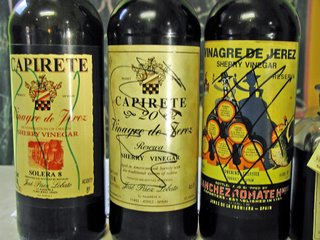
 (Ignore the scribbles on the labels - these were the sample bottles from the shelves, which - for obvious reasons - are marked.)
(Ignore the scribbles on the labels - these were the sample bottles from the shelves, which - for obvious reasons - are marked.)
We tasted 3 vinegars from Lobato (in the pictures above they all have the word capirete on their labels). One was 8 years old, one was 20 years old, and the last was 50 yrs old! Of course, as we discussed at some length, "years old" is a difficult thing to understand when it comes to sherry vinegars, or sherry for that matter, as they both use the solera system that blends wines or vinegars from different vintages.
Sherry vinegar is kind of interesting. There is a saying in Jerez, from which Sherry hails, that "each cask chooses its on destiny." Some casks of sherry wine age as normal, while others begin to turn to vinegar, and it's not always clear why this happens. Up until 1933, Sherry vinegar wasn't a commercial product. The wine makers always had it, and local cooks would get some from them as well, but no one was producing it for sale until 1933. Sherry vinegar, like Sherry, is made from the Palomino grape, and is aged in American oak barrels.
Unlike when we tasted the olive oils, where you want to breathe deeply and slurp air to maximize the flavors, we were advised to be much more cautious with the vinegars. So we smelled them from a distance while swirling the cups to waft the aromas up to our noses. And we took teeny-tiny sips, or even watered the vinegar down just a bit to be able to appreciate the flavors without the overwhelming acidity.
The 8 year old was the most "vinegary" of the bunch, with a quite high level of acidity. It had a really potent and aggressive nose too, with butterscotch and caramel and a hint of iodine. The 20 yr old vinegar was much more mellow - the nose wasn't harsh at all and had sweet caramely notes. It was smooth and rich and sweet on the tongue too (although you must understand that this is still vinegar we're talking about here, so sweet is relative!). The 50 year old had a really faint nose, and quite a different flavor than we expected. Sherry vinegars are quite different from balsalmic vinegars, which get more and more concentrated and sweeter as they get older. The progression isn't nearly so clear with Sherry vinegars, so this 50 year old vinegar was more acidic and less sweet than the 20 year old. But still not nearly as acidic as the 8 year old, of course! And its flavor was quite fruity.
Having tasted through this "vertical" of Lobate vinegars, we moved onto another producer - Romate - next. Romate is one of the last bodegas in Jerez that still fully locally owned. From them, we tasted a 25 year old standard sherry vinegar, and then a PX vinegar, made from Pedro Ximenex grapes rather than Palomino. The 25 year old was the consensus favorite of all of the standard sherry vinegars. It still smelled quite a bit like sherry, and was really quite sippable! Unlike the Lobate vinegars, which were dominated by dark notes like caramel and butterscotch, this vinegar had lots of high notes to balance the caramel that mostly showed up on a long finish.
The PX vinegar was quite a different beast. Its color was very deep chestnut in comparison to the tan of the others. It's production method is different as well - they take a base of really old vinegar and add to it a small amount of aged sherry, causing a second fermentation cycle as the new sherry turns to vinegar. After that is done, the vinegar is bottled. This complex approach shows through in a complex flavor profile, and the vinegar was another that was pretty "easy" to approach.
I already own a bottle of the 8 year old Sherry vinegar, so I didn't purchase any that night. But I might splurge and get the Romate 25 year old some time - one of the nice things about Sherry vinegar is that even the older bottles aren't very expensive. (With the exception of the PX, which retails for $60 at Zingerman's!)
At this point in the tasting we got to try out the oils and vinegars in some different contexts. First we each got to mix our own vinaigrette to eat with some salad greens (my combination was the Coupage olive oil and the 20 year old Lobate vinegar). Then we tried a small sample of Zingerman's cream of tomato soup alone, and then again with the last minute addition of a spoonful of 25 year old Sherry vinegar. Definitely a flavor enhancer! And we tasted some tomato sliced drizzled with the PX vinegar and sprinkled with sea salt. Again, the major effect was just to enhance the flavors of everything.
The last thing we did was to go back to the olive oils via a blind tasting, to see if we could identify one of the oils we'd tasted in the first go round. One of the attendees was too full to eat another bite, so she poured the mystery oil while the rest of us - including Gauri - waited in the hallway. The mystery oil was the La Amarilla de Ronda and - embarassingly - not a single one of us got it right! Gauri gave the prize (a small can of the LA) to the person who guessed the Coupage, because at least she'd guessed that it was a blend rather than a single varietal.
A very fun evening. These Zingerman's tastings are always a good time and educational too. And at $20 per person, they can be a good bargain, especially if - like me - you take advantage of your 20% off certificate (good that night only) to stock up on oils and vinegars for home!
Posted by
Tammy Coxen
at
2:00 PM
0
comments
![]()
Labels: tasting, zingerman's
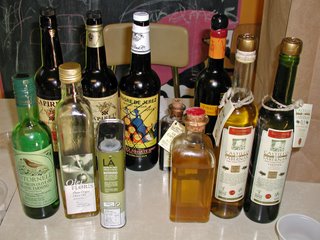 It's Spain month at Zingerman's, and last night I attended a tasting of Spanish olive oils and vinegars. Unlike most of their tastings, this one was pretty lightly attended - just 7 of us plus Gauri, our friendly and helpful guide for a tour through Spain.
It's Spain month at Zingerman's, and last night I attended a tasting of Spanish olive oils and vinegars. Unlike most of their tastings, this one was pretty lightly attended - just 7 of us plus Gauri, our friendly and helpful guide for a tour through Spain.
We started off by tasting 6 olive oils, alone and with bread. As with wine tasting, we started off by looking at the oil, then smelling it, and - finally - slurping it loudly to taste it. The flavor of the oil changes depending where on your tongue it's landing, so it's interesting to note how it evolves on its way down your palate. And you must watch out for the hit of pepper that can grab your throat on the way down. (In Italy, Gauri told us, they judge oils based on whether they are a "one-cough" or "two-cough" oil.)
The first two we tasted were both from near Barcelona, and both made exclusively from Arbequina olives. They were both a bright sunny yellow, with only a hint of green. The first, L'estornell, was a very light oil, with a fruity, grassy nose. It was the mildest of the oils we tasted, inspiring words like "silky, smooth, and delicate." It had just the slightest hint of pepper. The second, Olei Floris, had a very different nose with very strong aromas of tropical fruits and flowers. While the nose was interesting, the taste seemed really off to me - almost as if it was on the edge of rancidity. I raised it to Gauri's attention, and sure enough, a fresh bottle showed none of the characteristic I'd found objectionable. Whereas the L'estornell was very light, this oil was very viscous and thick, and the flavor was correspondingly round and full. Next, we moved South in Spain, to the Tabernas dessert. Where the oils of the North are mostly made from Arbequina olives, those from the south rely exclusively or in part on the Picual olive. The flavor from the Picual is much more assertive, and apparently Southerners refer to the oils of the north as "cat piss."
Next, we moved South in Spain, to the Tabernas dessert. Where the oils of the North are mostly made from Arbequina olives, those from the south rely exclusively or in part on the Picual olive. The flavor from the Picual is much more assertive, and apparently Southerners refer to the oils of the north as "cat piss."
Well, we all said upon sampling this next oil, we'd be thrilled if our cats pissed this! The Castillo de Tabernas 100% Picual oil was light green, with moderate viscosity. It was green on the nose too, with lots of different herbal aromas and a hint of mint. The flavor is green and quite assertive, with lots of pepper in the throat. Very different from the preceding Arbequina based oils - rustic rather than refined.
And very different from the next oil, a blend from the very same producer. The Castillo de Tabernas - Coupage is a blend of 60% picual, 20% arbequina, and 20% hoji blanca. A bright yellow-green oil, both the color and viscosity were lighter than the preceding oil. The nose was very floral. In taste, this was a very fresh and smooth tasting oil, with a hint of lemon or other citrus, and a lot of complexity. Tasting these two side by side illustrated the power of the blend - the 100% Picual oil was noticeably less complex, with a lot of up front flavor and a lot of pepper on the finish, but nothing in the middle.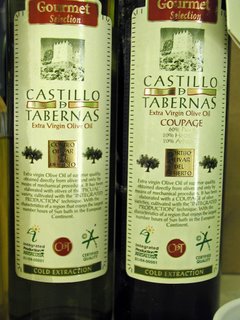
Next up was La Amarilla de Ronda. (You can see its stylish "LA" can next to the L'estornell and Olei Floris above.) Another blend of Arbequina, Picual and Hoji Blanca, this oil is made by a producer who is best known for making wine. He's taken a very winemaker-ish approach to olive oil, and purchases oil from two different villages, carefully blending them in an attempt to reflect the flavor of the region. (Gauri said that this all felt really pretentious to her, so she really wanted to dislike this oil. But then she tasted it.) Another yellow-green oil, with a nose of flower and fruit, it had quite the interesting evolution in my mouth. It opens very mild, then has a hint of fruity sweetness, before a really assertive peppery bite on the finish. Having taken a perhaps too-large slurp, I rated this one a three-cough! Very interesting.
The sixth and final oil was quite different from all the rest. Mariano's oil is from a town very close to the border of Portugal, at about the midway point north to south. It's made of 100% Manzanilla olives (not the kind usually marketed under that name, but a cousin). It was quite a pale yellow, with a very flowery and sweet nose. The nose was completely deceiving, however, as the flavor was extremely different from what the nose implied! It was very herbal and reminded me distinctly of oregano. It was quite complex and interesting, with a bitter finish that made it distinct from all of the other oils we tasted. It was also the oil that tasted most different with bread than on it's own, once again tricking your expectations. (In the topmost picture of this post, the Mariano's is the short square bottle in the front middle.)
And that was our pass through the olive oils. Next up: five very different Sherry vinegars.
Posted by
Tammy Coxen
at
8:34 PM
1 comments
![]()
Labels: tasting, zingerman's
 The black pig. Jamón Ibérico.
The black pig. Jamón Ibérico.
If you've read Peter Kaminsky's book Pig Perfect (and if you haven't, you should) then you'll know that Jamón Ibérico is the pinnacle that all other ham aspires to. It's produced only in particular regions in Spain, from one particular type of pig, and that pig must be raised in a particular fashion. In the period just prior to their slaughter, they feed only on acorns, which gives their fat a unique flavor and texture - and, strangely enough, makes the fat unsaturated! That's right - the king of ham is good for you.
Until very recently, Jamón Ibérico was not available in the US. But finally some Spanish producers have received permission from the US government to export their goods. Here's a website that's offering a wide range of Ibérico products. Beginning this month, Zingerman's Deli has joined the small group of vendors offering Iberico for sale. At this point, they "only" have three kinds of cured products available - chorizo, sauccison, and lomo (cured pork loin). They hope to have the actual ham in a few months.
According to this Wikipedia page, "Jamón ibérico only accounts for about 5% of Spain's cured-ham production, so it is very expensive." Very expensive is kind of an understatement. The two sausages Zingerman's is selling retail for $50 per pound. The lomo is even more expensive - a princely $100 per pound!
It is to Zingerman's credit that they are not letting those prices hold them back from pressing samples of pata negra on practically every customer who walks in the door! So I've managed to taste a number of slices of the lomo. Is it worth $100 per pound? Hard to say. It's intensely marbled - beyond marbled, in fact, the meat is downright speckled with fat. The flavor is subtle and smooth and sublime. It almost melts in your mouth. And fortunately, a little goes a long way - $10 worth of lomo would give you a lot of satisfaction without breaking the bank. The six paper thin slices shown above cost me $3 - a worthwhile expense for a treat to thank my husband for staying home with our two year old while I went out to Zingerman's to taste olive oils and vinegars (but more on that in another post).
Posted by
Tammy Coxen
at
10:24 PM
0
comments
![]()
Labels: meat, zingerman's
I host a monthly wine tasting group here in my cohousing community. We gather once a month and taste four wines on a given theme. Sometimes it's a varietal, other times a particular region or style. We taste all the wines "blind" so we're not biased by any preconceived notions we might have. First we taste them on their own, and next with food - it's amazing how many times a wine that has scored poorly in the first pass improves dramatically with some cheese or sausage or other nibble. And vice versa.
We have a lot of fun. We talk about the wines as we're tasting them, and point out different things that we're smelling or tasting. As such, the notes below represent a sort of "group mind" take on wine tasting notes. We each rank the wines on a five point and completely non-scientific scale - 1 is "blech," 2 is "okay, but not for me," 3 is "happy to drink it, wouldn't buy it," 4 is "really good, where can I get it?" and 5 is "great stuff - I'd take out a second mortgage to buy more." The numbers in the notes represent the average score, and then also the range among the group.
Last night we tasted four Chenin Blancs. Chenin Blanc is mostly grown in the Loire Valley region of France, in South Africa (where it is sometimes known as Steen), and also in California. Especially in California, it's often used as a fairly non-descript white blending wine, but there are a few producers doing interesting things with it. In France it reaches quite admirable heights in Vouvray and in some of the most ageworthy whites. Our tasting featured one from Vouvray in France, two very different wines from South Africa, and a Californian example.
Notes: 2004 Chateau de Montfort Vouvray FR
2004 Chateau de Montfort Vouvray FR
Very pale. Refreshing nose of straw and lemon-lime. Noticeable sweetness on the palate with a lingering tart finish as the sweet fades away. Green apple, pear and peach on the palate. Viscous and oily body. 3.5 alone, 3.3 food. 2/4 alone, 2/5 food.
$15.99, Everyday Wines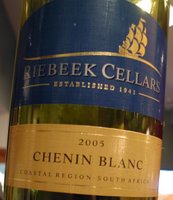 2005 Riebeek Cellars Chenin Blanc Coastal Region South Africa
2005 Riebeek Cellars Chenin Blanc Coastal Region South Africa
Very pale. Floral nose, with mineral metallic notes. Prominent mineral on the palate, but also some citrus and honeydew melon. A touch of bitterness on the finish. Light bodied with high acidity. 2.7 alone, 3.0 food. 2/4.5 alone, 2/4 food.
$8.99, Everyday Wines 2005 Ballentine Vineyards Old Vines Chenin Blanc Pocai Vineyard Napa Valley California
2005 Ballentine Vineyards Old Vines Chenin Blanc Pocai Vineyard Napa Valley California
Very pale. Alcoholic nose, with cantaloupe and a little bit of grass. Big wine - floral, tangy and juicy, with some bitterness on the finish. Fully dry, but lots of fruit. Good balancing acidity, but not sour. Full, but without any viscosity or oil. Good complexity. 3.3 alone, 2.7 food. 2/5 alone, 1/5 food.
$14.99, Village Corner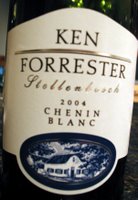 2004 Ken Forrester Chenin Blanc Stellensbosch South Africa
2004 Ken Forrester Chenin Blanc Stellensbosch South Africa
Straw yellow. Nose has honey, oil, flowers, straw and perhaps a bit of apple. On its own, the palate is extremely recalcitrant - hard to get anything from this low acid and full bodied wine except a spicy white pepper finish that lingers. But with food, it's a different wine entirely, and opens up with all kinds of layers of flavors. 3.0 alone, 3.9 food. 2/4 alone, 2/5 food.
$13.99, Village Corner
One of our members works at Zingerman's, so we put him in charge of picking up the munchables. Last night we had three kinds of cheese - a Rolf Beeler 2 yr Gruyere from Switzerland, Tomme de la Chataignerie (an alpine sheep and cow milk cheese from France), and Leonora, a raw milk goat cheese from Spain. And a little bit of dried tomato pesto I whipped up from some tomatoes a neighbor had dried.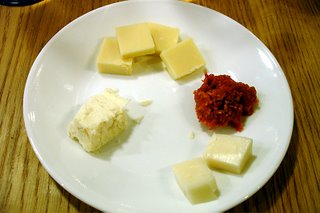 That Gruyere has always been a big favorite of mine. Sweet and mellow, with nice crunchy crystals. The Tomme was new to me. Salty and soft, with a distinctly grassy flavor. And goat cheese was excellent, very crumbly but not chalky and wonderfully goaty (but I'm an absolute sucker for goat cheese, so it's kind of a given that I'd like it). The pesto turned out quite well for something I just whipped up on the spur of the moment.
That Gruyere has always been a big favorite of mine. Sweet and mellow, with nice crunchy crystals. The Tomme was new to me. Salty and soft, with a distinctly grassy flavor. And goat cheese was excellent, very crumbly but not chalky and wonderfully goaty (but I'm an absolute sucker for goat cheese, so it's kind of a given that I'd like it). The pesto turned out quite well for something I just whipped up on the spur of the moment.
And I don't mean one who's so standoffish you doubt he could be human.
Read more here.Researchers at NEC System Technologies and Mie University have designed a robot that can taste — an electromechanical sommelier able to identify dozens of different wines, cheeses and hors d'oeuvres.
"There are all kinds of robots out there doing many different things," said Hideo Shimazu, director of the NEC System Technology Research Laboratory and a joint-leader of the robot project. "But we decided to focus on wine because that seemed like a real challenge."
Posted by
Tammy Coxen
at
9:53 PM
0
comments
![]()
 Our Michigan blueberries are fading into a distant and expensive memory. There were still a few at the Farmer's Market on Saturday, but they are up to $5 a pint - a few weeks ago they were $6 a quart. Fortunately, the raspberries are in full swing, and they made a delightful topping for homemade pancakes this morning.
Our Michigan blueberries are fading into a distant and expensive memory. There were still a few at the Farmer's Market on Saturday, but they are up to $5 a pint - a few weeks ago they were $6 a quart. Fortunately, the raspberries are in full swing, and they made a delightful topping for homemade pancakes this morning.
It's a pretty generous topping, and that's because fresh, local, raspberries are ephemeral. Yes, they are soft, juicy, tart and yielding. But the very ripeness that gives them their deep red color and divine flavor means that they turn from marvelous to moldy in a minute. So they invite excess. The race is on - can we eat an entire quart of raspberries before they go bad? (So far the answer has been yes.)
Supermarket raspberries might as well be another species entirely. Here's a picture I took today of a package I bought about a week and a half ago, in a momentary lull in my supply of the fresh local kind.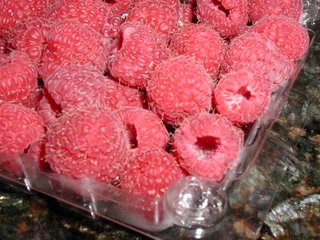 10 day old raspberries, and not a spot of mold on them. Excellent for shipping, not so good for eating. They're as firm as they look, with large noticeable seeds. Dry, not juicy. More pink than red. And, well, the flavor just isn't much to speak of.
10 day old raspberries, and not a spot of mold on them. Excellent for shipping, not so good for eating. They're as firm as they look, with large noticeable seeds. Dry, not juicy. More pink than red. And, well, the flavor just isn't much to speak of.
Come winter I'll probably be happy to have something - anything - even a pale imitation of late summer's flavor. But for now, I'm happy that I've got three farmer's markets a week at which to stock up on the real thing.
Posted by
Tammy Coxen
at
9:41 PM
0
comments
![]()
Labels: fruit
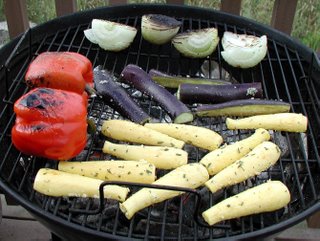 I've never been a big ratatouille fan. But when today's visit to the Farmer's Market resulted in a pile of eggplant, summer squash and red pepper on my counter, it seemed like the obvious choice. Fortunately, a recent issue of Fine Cooking (my current favorite cooking magazine) contained a great article on the art of ratatouille making. I agree completely with the author's assessment of where traditional ratatouille recipes go wrong:
I've never been a big ratatouille fan. But when today's visit to the Farmer's Market resulted in a pile of eggplant, summer squash and red pepper on my counter, it seemed like the obvious choice. Fortunately, a recent issue of Fine Cooking (my current favorite cooking magazine) contained a great article on the art of ratatouille making. I agree completely with the author's assessment of where traditional ratatouille recipes go wrong:
While there's nothing wrong with the concept of ratatouille - a medley of these vegetables accented with garlic and onion, fresh herbs, and some fruity olive oil - the execution of the dish is often a big fat disappointment for me. Most ratatouille just feels like vegetable porridge. Looking through a half-dozen cookbooks, I saw instructions to "simmer," "stew," or even "boil" - the idea being to marry the flavors of the vegetables. But for me, too much togetherness just makes the dish bland. The vegetables lose their own personalities, and the texture gets so mushy.The author presents two solutions - one where the vegetables are individually sauteed and combined, and another where everything is chopped up and roasted together. I thought the dry heat of grilling could duplicate the roasting effect, and give a nice smoky flavor at the same time. I'm pleased to say it was a very successful experiment.
Posted by
Tammy Coxen
at
8:45 PM
0
comments
![]()